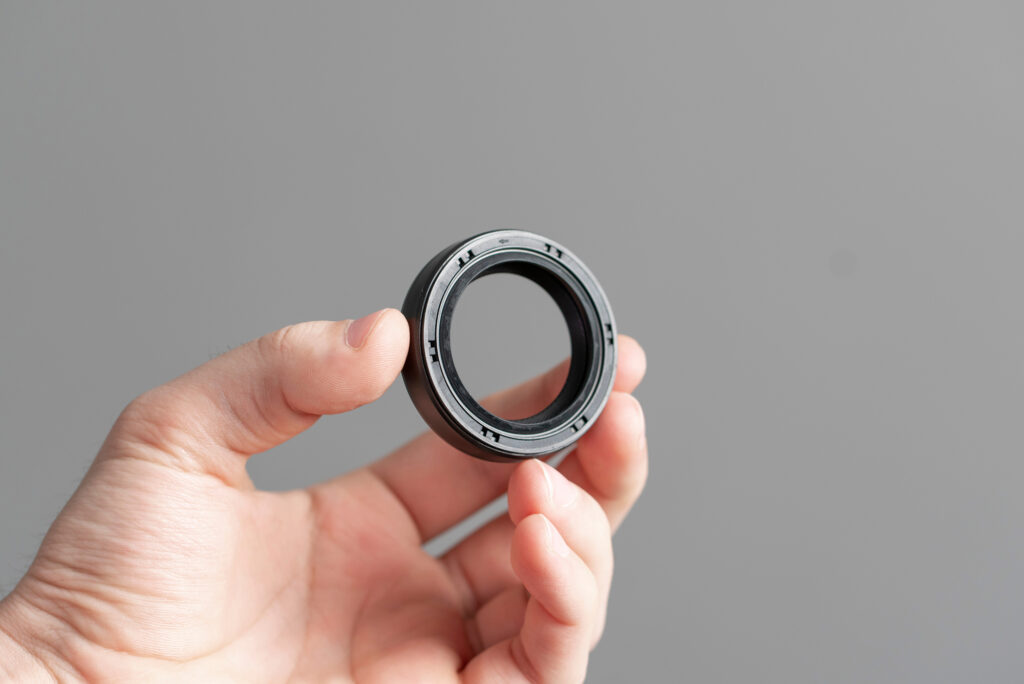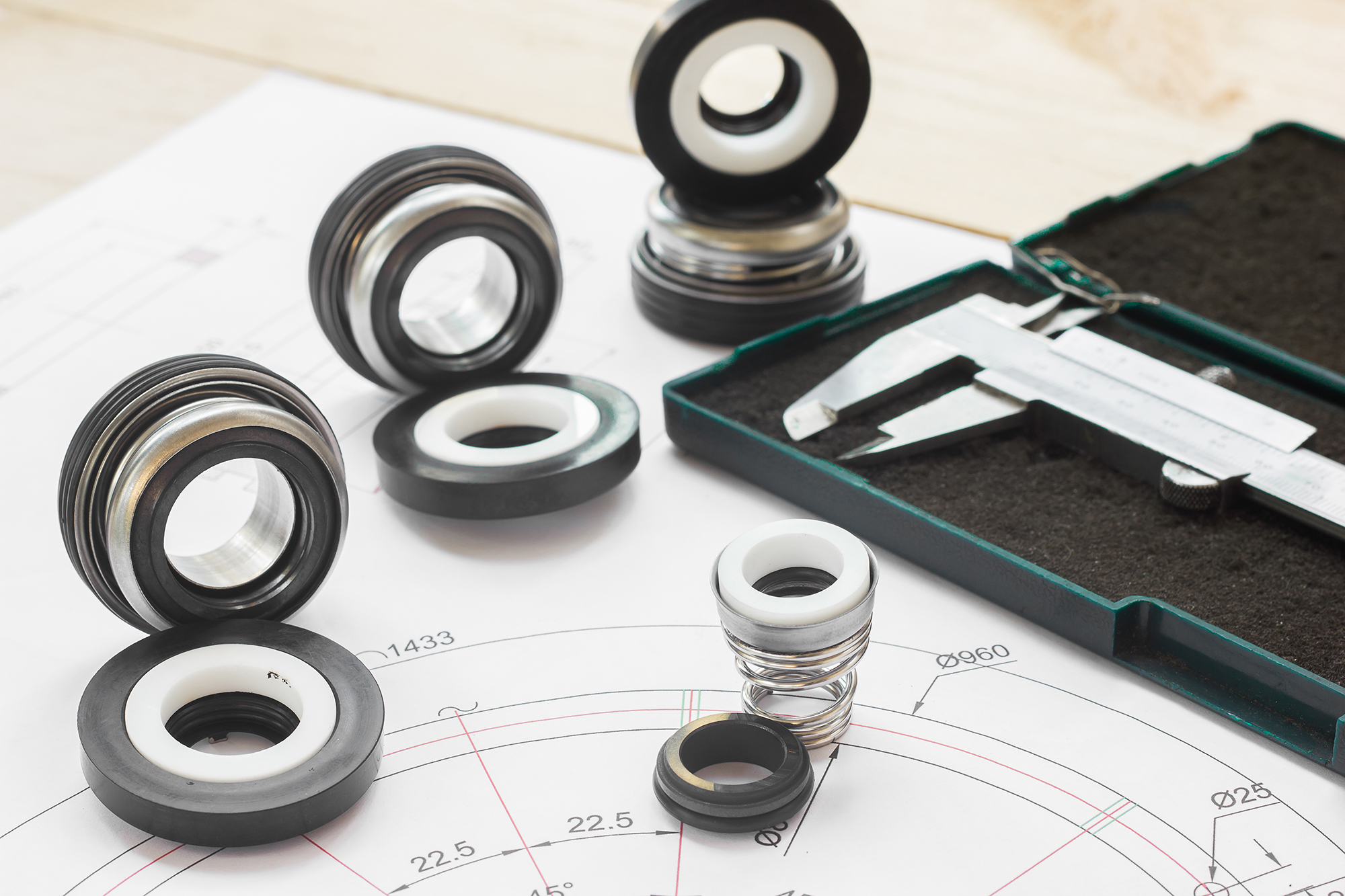When designing seals for tough applications, your o-ring should be your first point of consideration. Choosing the right o-ring for harsh environments will make or break your seal. It can be frustrating and difficult to find a well-designed o-ring made from the right material for your environment, but you can start by considering the primary factors that will impact your seal, including but not limited to:
- Temperature
- Chemical exposure
- Steam
- Pressure
- Dynamic or static applications
Once you determine these parameters, you can tackle the next hurdle: choosing your o-ring material.
Choosing Your O-Ring Material
Depending on your parameters and application, certain rubbers or plastics might be better suited for your needs. We have compiled a list of four common formulas best suited for a variety of applications and price points.
Perfluoroelastomers (FFKM)
Perfluoroelastomer (also known as FFKM) was first developed in the 1960s. It is a fluorinated, carbon-based synthetic rubber. FFKM is known for its chemical resistance, heat resistance, and high-performance capabilities. FFKM is the typical choice for many applications. Although it can be on the expensive side, FFKM usually outlasts inferior alternatives, making it more cost effective in the long-run.
-
Pros:
- Features high temperature ratings, up to approximately 635°F (335°C), and lower temperatures, going down to -49°F (-45°C)
- Nearly universal chemical compatibility
- Excellent gas and liquid permeation resistance
- Excellent weather ability and ozone resistance
- Self-extinguishing and non-flammable in air
- Low outgassing properties (low extractables)
- Good mechanical properties, improving sealing performance
- Suitable for explosive decompression, CIP (Clean in Place), SIP (Steam in Place), USP Class VI, and FDA
-
Cons
- FFKM should not be used with molten or gaseous alkali metals
- Premium cost
Related: Four types of perfluoroelastomers
What applications is FFKM best suited for?
FFKM is best suited for high temperature applications where other materials would fail. We see FFKM in almost every industry, but particularly oil and gas (where its rapid gas decompression and explosive decompression qualities are critical), medical and pharmaceutical applications (as it can withstand autoclaving and gamma radiation), and semiconductors.
Some specific FFKM applications include:
- Liquid chromatography equipment
- Mechanical seals
- Painting equipment
- Pumps & valves
- Aerospace fuels, Skydrol & oils
FFKM is also suited for a number of semiconductor applications:
- Chemical sprayers, injectors and reactors
- Connectors, Controls & Filters
- Petro-Chem equipment, Sour gas
- Ink handling & spraying equipment
- Inorganic & Organic Acids & Alkine
- Ketones, Esters, Ethers, Aldehydes
- Etch
- Strip
- LPCVD
- Litho/Track
- ECP
- Exhaust valves
Polytetrafluoroethylene (PTFE)
Polytetrafluoroethylene is also known as PTFE or teflon. Similar to FFKM, PTFE has a high molecular weight of fluorine and carbon. PTFE is a hard plastic, though, making it inelastic and very rigid, whereas FFKM is extremely flexible.
-
Pros:
- Unaffected by all known acids, alkalis, and solvents allowing for maximum chemical resistance
- Low coefficient of friction, making it an excellent nonstick option
- Very wide temperature range, from -329°F (-200°C) to 482°F (250°C)
- Chemically inert
- Self-cleaning
- Durable
- Non-flammable
- Good corrosion resistance
- High electrical resistance
-
Cons:
- Very hard; therefore, it exhibits poor compression set
- It cannot be cemented
- It is unweldable
What applications is PTFE best suited for?
PTFE is best suited for applications that do not need a high compression set, but also need excellent chemical and temperature resistance. This includes medical devices, coatings, and pest control. It also works well in ultra-low temperatures, such as aerospace, and automotive manufacturing.
Ethylene Propylene (EPDM)
Ethylene Propylene (EPDM) is an extremely durable copolymer that offers some of the best cold temperature resistance that can be found.
-
Pros:
- Excellent resistance to ozone, sunlight, and weathering
- Can withstand extremely cold temperatures, with an operating temperature as low as -58°F (-50°C) (with highs of 302°F (150°C))
- Compresses well
- Highly resistant to tears, abrasion, and steam
- Adheres to metal very well
- Works well with adhesives
-
Cons
- Does not fare well with fuels, oils, and non-polar solvents
What applications is EPDM best suited for?
EPDM is best suited for weatherproofing because it can withstand elements extremely well. It is frequently found in roofing, windows, doors, cell towers, and other outdoor applications. It also works well with applications that use steam, as well as automotive brake fluid, vibration dampeners, and isolators.
Nitrile Butadiene Rubber (NBR)
Nitrile Butadiene Rubber (NBR) is one of the most popular elastomers on the market. It is very common in a number of applications due to its low cost and comprehensive benefits. NBR can be a potential solution for harsh environments, such as extremely abrasive applications.
-
Pros:
- Excellent abrasion resistance.
- Good compression set
- Good tear resistance
- Good non-polar solvent resistance
- Good water resistance
- Good oil resistance
- Cheaper than fluoroelastomers
- Good low temp resistance to -65°F (-54°C)
- Good oil and fuel resistance
- Low cost
-
Cons:
- Poor ozone, sunlight, and weather resistance
- Limited high temperature resistance
- Poor flame resistance
What applications is NBR best suited for?
NBR is used universally in basic sealing applications because it is low cost and offers comprehensive benefits as well as physical properties. We see it often in automotive, water treatment and filtration, and pool and spa applications.
In harsh environments, NBR excels in aerospace and other low temperature applications. It also functions well in dynamic applications where other polymers would fail.

Making Your Final Decision
In harsh environments, choosing the right material for your o-ring is the first thing you should do, but there are numerous other considerations. You might need a different shape or size than you originally intended. While you might originally consider NBR due to its price point, it might fail so often that an FFKM o-ring could have saved you money from the start, even with a higher initial investment.
The best thing you can do to make your final decision is to work with a sealing expert who can offer you their expertise and custom solutions. Take this example, for instance, when a manufacturer of high-pressure vessels came to our engineers here at Marco Rubber looking for a solution.
They needed a seal for a high pressure, high temperature vessel that needed to resist 20,000 PSI and temperatures as high as 550°F. As an added difficulty: it had to fit into a regular o-ring groove with no back-up rings.
Our team was able to identify one of our proprietary high temperature perfluoroelastomer compounds, Markez Z1028, that can withstand temperatures up to 600°F. Our experts also spotted a few design components that could be improved to prevent the formation of an extrusion gap on the metal joints at high temperatures.
By making these changes and using the recommended Markez compound, this manufacturer had a functioning seal that passed all required testing and was put into operation!
Our FFKM line, Markez, has been the solution for many manufacturers. We have compounds to fit almost every need, including one that is manufactured, cleaned, and packaged in a cleanroom for ultrapure requirements. It is available at both a fraction of the cost and the lead time of other FFKM formulations, with an average 6-8 week lead time.
Not to mention you get the benefit of working with our experts to develop a solution just for you! If you want an expert’s eyes on your design and their expertise to save you work down the line, contact us today.
